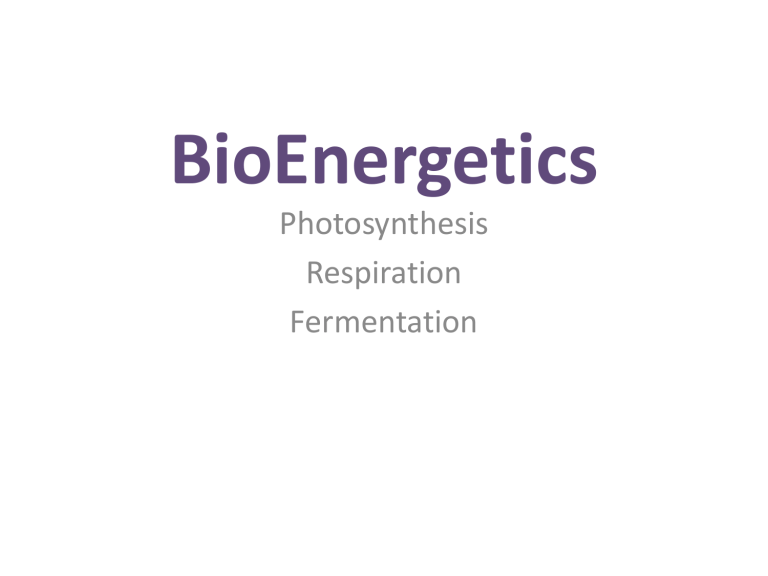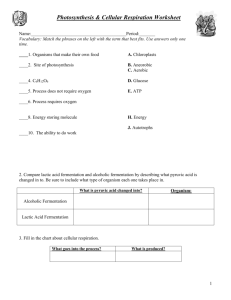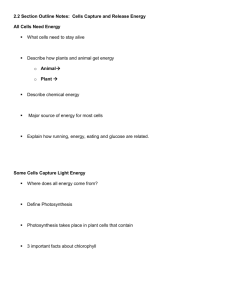PPT

BioEnergetics
Photosynthesis
Respiration
Fermentation
Warm-Up
What is the difference between autotrophs and
heterotrophs???
Compare & Contrast Autotrophs and
Heterotrophs
• AUTOTROPHS
• “Self-Feeder”
HETEROTROPHS
• “Eater of others”
• Aka “Producers” (plants) • Aka “Consumers” (animals)
• Use light energy to make their own food (organic molecules called glucose).
• Must obtain food by eating producers or other consumers and release energy from it.
Processes used:
• Photosynthesis
• Cellular Respiration •
Process used:
Cellular Respiration
What is “Energy” in Biology???
Adenosine Triphosphate = ATP
ATP is a high energy molecule produced in the
Mitochondria (cell organelle)
It is made in a process called cellular respiration
What ATP is and How it
Works - BioVid Episode
3 - YouTube
What is the relationship between photosynthesis and cellular respiration?
The products of photosynthesis are the starting materials for cellular respiration!!!
The products of cellular respiration are the starting materials for photosynthesis!
What is the relationship between photosynthesis and cellular respiration?
Photosynthesis = makes food
(glucose)
Cellular Respiration
= breaks that food
(glucose) down to release energy (ATP)
1. The Products of
Photosynthesis (Oxygen &
Glucose) are used by humans for Respiration.
2. Animals use the oxygen
(they breath) to break down glucose sugar.
3. Animals exhale Carbon dioxide as a by product.
4. Plants use the products of cellular respiration (carbon dioxide) for photosynthesis.
Warm-Up
1. Determine if the following organisms are autotrophs or heterotrophs and give your reasoning.
2. Which process are the following descriptions referring to?
A: process in which glucose (food) is made
B: process that releases stored-up energy from glucose (food)
CELLULAR RESPIRATION
Process that allows organisms to obtain the energy stored in food (glucose)
• Uses oxygen to convert chemical energy
(stored in food) into a useable form of energy called ATP (adenosine triphosphate)
• Occurs in the Mitochondria
WHAT THE … ENERGY?
• Energy ORIGINATES (comes from) the sun!
• Sunlight energy is HARNESSED by plants (producers) and is STORED in the form of food (glucose) through PHOTOSYNTHESIS .
• CELLULAR RESPIRATION allows the energy to be released from food
(glucose) as ATP
ATP
Adenosine Triphosphate
• Stores LOTS of Potential Energy!!
• The energy can be released if a phosphate is
“pulled off” and the bond is broken!
• Structure:
– Adenine
– Sugar
– 3 (“tri”) phosphates
High Energy
Bond!!!
What ATP is and How it
Works - BioVid Episode
3 - YouTube
Quick Review of Chemical Equations and Formulas
1. C
6
H
12
O
2 = How many carbons are in this molecule?
2. 2H
2
O + 2CO
2
2H
2
CO
3
+ heat
• What materials are the products?
• What does the “ ” represent?
• What is CO2?
• What is H2O?
• How many waters go into the reaction?
Equation for Cellular Respiration
C
6
H 12 O 6 + O 2
CO 2 + H 2 O +
38 ATP
Glucose + Oxygen Carbon Dioxide + water + 38 ATP (energy)
3 Steps of Cellular Respiration
1. Glycolosis
– aka “splitting of water”
– Glucose (6-carbon molecule) is split into two
Pyruvic Acids (3-carbon molecules)
– Anaerobic Process (does NOT need oxygen)
+ H2O
Glucose Pyruvic Acids
3 Steps of Cellular Respiration
1. Glycolosis (Split Glucose into 2 pyruvic acids)
2. KREBS Cycle –
pyruvic acids are transformed into Acetyl-CoA molecules
• Aerobic Process (needs oxygen)
3 Steps of Cellular Respiration
1. Glycolosis (Split Glucose into 2 pyruvic acids)
2. KREBS cycle (turn pyruvic acids into acetyl-CoA molecules)
3. Electron Transport Chain
– Occurs on membrane of mitochondria
– Electrons are passed down a “chain” of molecules to release H+ ions
– H+ ions flow through “machines” that make ATP molecules H+
H+
H+
H+
H+
H+
H+
H+
H+
H+ e-
ATP
Warm-Up
1. When plants harnesses the sun’s energy, they
2. The goal of cellular respiration is to produce
_________ molecules.
3. What are the 2 products of photosynthesis?
(THINK!!) Glucose oxygen
What is the relationship between photosynthesis and cellular respiration?
The products of photosynthesis are the starting materials for cellular respiration!!!
The products of cellular respiration are the starting materials for photosynthesis!
PHOTOSYNTHESIS
Process in which plants use light energy (sunlight) to make food (glucose)
• Occurs inside plant cells in the chloroplasts.
• Chloroplasts contain chlorophyll (green pigment that absorbs the sun’s energy)
Structure of a Chloroplast
Thylakoids – contain chlorophyll pigment
Stroma – liquid-filled space inside a chloroplast
Granum – a stack of thylakoids
Equation for Photosynthesis
6CO2 + 6H20 + sunlight C6H12O6 + 6 O2
Carbon dioxide + water + sunlight glucose + oxygen
What is Photosynthesis -
YouTube
Equation for Photosynthesis
6CO2 + 6H20 + sunlight C6H12O6 + 6 O2
Carbon dioxide + water + sunlight glucose + oxygen
What is Photosynthesis -
YouTube
2 Steps of Photosynthesis
1. Light Reactions
– Require sunlight!
– Occurs in the thylakoids of the chloroplasts
– “splits water” to produce oxygen gas and energy molecules (ATP & NADPH)
1. Light Reactions
2. Calvin Cycle
– Does NOT require sunlight!
– Uses ATP & NADPH (made during light reactions) to produce glucose molecules (food)
Photosynthesis
- YouTube
Factors Affecting Photosynthesis Clues
1. What happens to plants when you don’t water them???
2. What happens to plants if you keep them in a
REALLY hot place?
3. What happens to trees when the days get shorter
(winter time) and the sun isn’t out as long during the day???
Things that affect photosynthesis:
1.
2.
3.
Warm-Up
1. List the 2 products of photosynthesis
Glucose & oxygen
2. List the 2 step/stages of photosynthesis (in order) light reactions & calvin cycle
3. List 2 of the 3 things that affect photosynthesis.
amount of water amount of sunlight temperature
Parts of a Plant Overview
1. In what part of this plant does photosynthesis occur??
2. What part of this plant is for attracting pollinators?
3. In what part(s) of this plant does meiosis take place?
Ovary & Anther
Petal
Leaf
Structure of a Leaf
Stomates!
Leaf Structure Lab
Each person will be completing the lab portion where they will be observing the leaves under the microscope and sketching.
Small groups will be completing the analysis portion of the lab together and handing in one with everyone’s name on it.
Your final grade will be dependent on both your individual and group parts of the lab.
LEAF LAB PROCEDURE
PART A
1. Obtain a microscope and prepared slide of a cross-section of a leaf.
2. Using your notes and textbook, observe the various leaf tissues and structures on the leaf and label/color-code the illustration on your lab.
3. Return your microscope and slide to the location indicated by the teacher.
LEAF LAB PROCEDURE (cont.)
Part B
1. Obtain a leaf from your teacher.
2. Paint a THIN layer of clear nail polish over the BOTTOM of the leaf.
3. Wait until polish is dry (1-2 min).
4. Peel off polish with tape and stick on microscope slide.
5. View under microscope and complete a sketch of 2-3 stomata. Be sure to label guard cells and stoma.
Warm-Up
1. What organisms undergo photosynthesis?
2. What is the product of photosynthesis?
3. In what organelle (inside the cell) does photosynthesis take place?
4. What green pigment is essential to absorb the sun’s energy?
5. List the two stages of photosynthesis and tell which one actually makes the glucose?
So far, we’ve talked about:
1.
Cellular Respiration
2.
Photosynthesis
Now we are going to talk about
FERMENTATION
!
**it is a modified version of cellular respiration**
So let’s refresh our memories…
1. What is the purpose/goal of cellular respiration?
Break down glucose to make ATP energy !
2. What were the 2 steps of normal cellular respiration?
1. Glycolosis & 2. KREBS cycle !
3. Using the equation below, determine what is NEEDS to be present in order for cellular respiration to take place.
Sugar & Oxygen !
C
6
H 12 O 6 + O 2
CO 2 + H 2 O + 38 ATP
FERMENTATION
Before we can talk about fermentation…we must be able to understand the difference between “aerobic” and “anaerobic” conditions!
Aerobic =
Anaerobic =
FERMENTATION
Process where cells make ATP (energy)
without oxygen available (anaerobic!)
Some organisms do it naturally & for some organisms…it is a last resort to stay alive!
• Goal = Make ATP (energy) molecules
(just like cellular respiration)
• Less Efficient!!!
– Cellular Respiration makes 38 ATP’s
– Fermentation only makes 2 ATP’s
Okay, no oxygen…..so what now??
FACT: Cells MUST make ATP energy to stay alive!!
(either via cellular respiration OR fermentation)
If no oxygen is available for normal cellular respiration
(which makes 38 ATP’s) then cells are forced to do fermentation
( which only makes 2 ATP’s)… but at least they are getting some energy!
KREBS Cycle
Makes 38 ATP molecules!
1.
Glycolosis
Glucose 2 pyruvic acids
Lactic Acid Fermentation
(makes lactic acid & 2 ATPs)
Alcoholic Fermentation
(makes ethanol & 2 ATP’s)
2 Types of Fermentation
1. Lactic Acid Fermentation
– Occurs in human muscle cells
– During exercise (when oxygen is all used up)
– Produces small amounts of ATP for muscles to keep working
(when our reserved ATP runs out)
– Lactic acid byproduct makes muscles feel “sore”
Glucose 2 ATP + carbon dioxide + lactic acid
Warm-Up
On the Yeast Demo Sheet, complete this warm-up. Use your notes from yesterday if necessary!!!
1. When NO OXYGEN is present for a chemical reaction, we say that the conditions are ___________________.
2. What prefix have we learned that helped you (or could help you) figure out the answer to question #1?
AN = not/without
3. Fermentation is similar to what process we’ve already learned about in this class?
CELLULAR RESPIRATION
4. What is the goal/purpose of fermentation?
MAKE ATP (energy)
5. Why is fermentation a “last resort” for most organisms?
INEFFICIENT! (Only makes 2 ATPs)
LACTIC ACID
6. Human muscle cells undergo ___________________ fermentation when they become fatigued/tired during exercise.
Today’s Objectives
1. Explain the purpose of alcoholic fermentation.
2. Distinguish between alcoholic and lactic acid fermentation.
3. Understand the basic reaction (reactants & products) of alcoholic fermentation through use of a yeast fermentation demonstration.
Highlights for Today:
1. Notes on Alcoholic Fermentation
2. Fun & equally educational Fermentation DEMO
3. Group work Analysis of DEMO
2. Alcoholic Fermentation
– Occurs in YEAST (type of unicellular fungus) & some bacteria
– Food (glucose) is broken down to produce energy
(ATP)
– Makes alcohol & carbon dioxide
(as byproducts)
– Process is used to make cheese, bread rise & alcoholic beverages
Glucose 2 ATP + carbon dioxide + ethyl alcohol yeast | Search |
Discovery Education
FERMENTATION DEMO
We will be setting up an apparatus to observe & understand yeast undergoing fermentation:
Basic Set-Up
Ingredients in the flask:
1. Water
2. Sugar (sucrose breaks down into glucose)
3. Yeast (remember this is a unicellular fungus)
** We will be covering the flask with a balloon**
Yeast
Water
Sugar
Hypothesis (think/pair/share)
1. What specific type of fermentation is happening in the flask?
2. List ALL 3 products that will be produced as a result of the fermentation? Will you be able to see all of them in front of your eyes?
3. Based on our set-up, how will we be able to tell if fermentation is actually taking place?
(What will you see happen and WHY?!?!)
Blind FA
Groups for Analysis
Analysis of DEMO
1.
Identify: Describe 2 observations from the apparatus that proves alcoholic fermentation is occurring.
2.
Explain: How does the yeast in the flask benefit from undergoing fermentation?
3.
Infer: If the solution in the flask (yeast, water, & sugar) was boiled, how do you think that would affect our results??
4.
Evaluate: Would you expect alcoholic fermentation take place in this flask?
(Explain your answer & what you would expect to observe)
Water yeast
5. Reason: Yeast carry out alcoholic fermentation (produces much less ATP than cellular respiration). Based on what you know about yeast cells, predict why fermentation alone is sufficient for them to survive?
6. Speculate: If the yeast were given a more complex sugar, how might that affect the rate of fermentation?
7. Evaluate & Connect: Below is a graph showing amount of carbon dioxide produced by the yeast over time (using the same experiment/apparatus we did). Why do you think the amount of
CO2 being produced “levels off” as time progresses?
Revisit Today’s Objectives
1. Explain the purpose of alcoholic fermentation.
2. Distinguish between alcoholic and lactic acid fermentation.
3. Understand the basic reaction (reactants & products) of alcoholic fermentation through use of a yeast fermentation demonstration.








